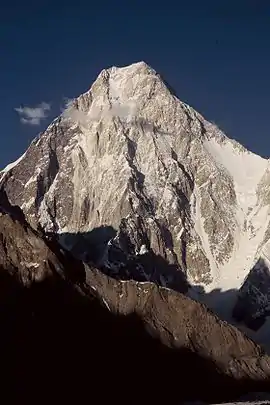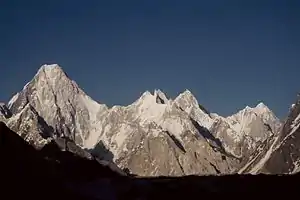Gasherbrum IV
Gasherbrum IV (Urdu: گاشر برم -4; simplified Chinese: 加舒尔布鲁木IV峰; traditional Chinese: 加舒爾布魯木IV峰; pinyin: Jiāshūěrbùlǔmù IV Fēng), surveyed as K3, is the 17th highest mountain on Earth and the 6th highest in Pakistan. It is one of the peaks in the Gasherbrum massif.
| Gasherbrum IV | |
|---|---|
 Gasherbrum IV from Baltoro Glacier | |
| Highest point | |
| Elevation | 7,925 m (26,001 ft) [1] Ranked 17th |
| Prominence | 718 m (2,356 ft) [2] |
| Coordinates | 35°45′30″N 76°37′0″E[2] |
| Geography | |
 Gasherbrum IV Location of Gasherbrum IV  Gasherbrum IV Gasherbrum IV (Gilgit Baltistan) | |
| Location | Gilgit-Baltistan region, Pakistan |
| Parent range | Baltoro Muztagh, Karakoram |
| Climbing | |
| First ascent | August 6, 1958 by Walter Bonatti and Carlo Mauri |
| Easiest route | snow/ice climb |
The Gasherbrums are a remote group of peaks located at the northeastern end of the Baltoro Glacier in the Karakoram range of the Himalaya. The massif contains three of the world's 8,000 metre peaks (if one includes Broad Peak). Gasherbrum is often claimed to mean "Shining Wall", presumably a reference to the highly visible west face of Gasherbrum IV; but in fact, it comes from "rgasha" (beautiful) and "brum" (mountain) in Balti, hence it actually means "beautiful mountain."[3]
Notable ascents and attempts

Walter Bonatti on the Gasherbrum IV summit during first ascent in 1958
- 1958 First ascent by Walter Bonatti and Carlo Mauri on an Italian expedition led by Riccardo Cassin via the northeast ridge and the north summit. Traversing the pinnacled ridge to the main summit was considered the crux of the climb.[4]
- 1985 First ascent of the 2,500 m (8,200 ft) high west face ("Shining Wall") by Wojciech Kurtyka (Poland) and Robert Schauer (Austria). However, bad weather, depletion of food and fuel, and extreme exhaustion forced them to stop at the north summit.[4] The editors of Climbing magazine considered it the greatest achievement of mountaineering in the twentieth century.
- 1986 First ascent of the northwest ridge by Greg Child, Tim Macartney-Snape and Tom Hargis, involving an open bivouac on the north summit. This was the second ascent of Gasherbrum IV.[4][5]
- 1997 First complete ascent of the west face by a Korean team, via the central spur. Bang Jung-ho, Kim Tong-kwan and Yoo Huk-jae reached the summit after a sieged ascent quoted as 5.10 A3.[4]
- 1999 Second ascent of the northwest ridge by Kang Yeon-ryong and Yun Chi-won, part of a 13-member Korean team.[4]
- 2008 Third ascent of the northwest ridge by a Spanish team composed of Alberto Iñurrategi, Juan Vallejo, José Carlos Tamayo, Mikel Zabalza, and Ferran Latorre.[6] The team did not get to the main summit, but stopped at a minor peak a short distance from the true summit.[7]

Left to right: Gasherbrum IV, VII, V, VI[8]
See also
- List of mountains in Pakistan
- List of highest mountains
References
- "Gasherbrum IV". SummitPost.org. Retrieved 5 June 2013.
- "Gasherbrum IV". Peakbagger.com. Retrieved 5 June 2013.
- H. Adams Carter, "Balti Place Names in the Karakoram", American Alpine Journal 49 (1975), p. 53.
- Griffin, Lindsay (August 30, 2008). "Gasherbrums Update". Alpinist Newswire. Alpinist Magazine. Retrieved Nov 16, 2009.
- Child, Greg (1987). "Gasherbrum IV's Northwest Ridge". American Alpine Journal. New York, NY, USA: American Alpine Club. 29 (61): 17–25. ISBN 0-930410-29-7.
- Carbonell, Rafael (August 8, 2008). "Oro en el Himalaya". El País.
- "mounteverest.net - Interview with Juan Vallejo, member of the Spanish team". Archived from the original on 2009-03-29. Retrieved 2009-04-08.
- Jerzy Wala, The Eight-Thousand Metre Peaks of the Karakoram (orographical sketch map, revised), Kraków, Poland, 1994
This article is issued from Wikipedia. The text is licensed under Creative Commons - Attribution - Sharealike. Additional terms may apply for the media files.